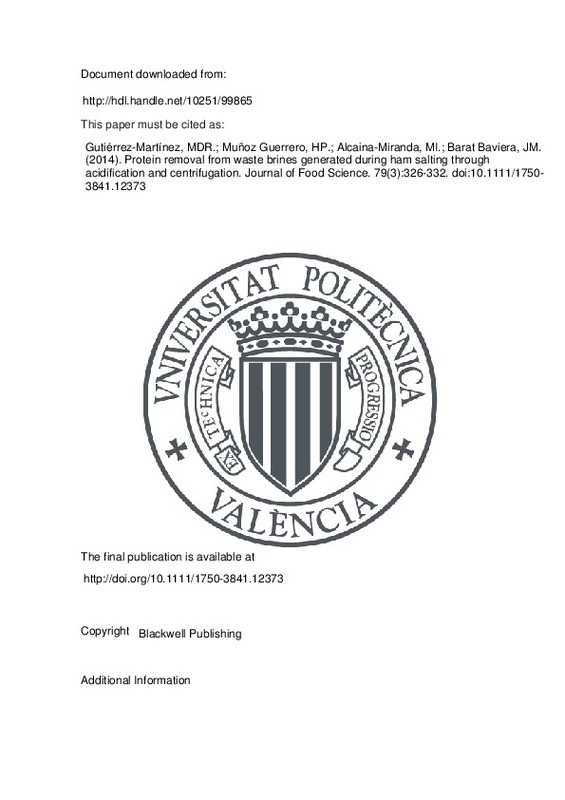JavaScript is disabled for your browser. Some features of this site may not work without it.
Buscar en RiuNet
Listar
Mi cuenta
Estadísticas
Ayuda RiuNet
Admin. UPV
Protein removal from waste brines generated during ham salting through acidification and centrifugation
Mostrar el registro sencillo del ítem
Ficheros en el ítem
| dc.contributor.author | Gutiérrez-Martínez, María Del Rosario
|
es_ES |
| dc.contributor.author | Muñoz Guerrero, Hernán Patricio
|
es_ES |
| dc.contributor.author | Alcaina-Miranda, María Isabel
|
es_ES |
| dc.contributor.author | Barat Baviera, José Manuel
|
es_ES |
| dc.date.accessioned | 2018-03-28T13:43:13Z | |
| dc.date.available | 2018-03-28T13:43:13Z | |
| dc.date.issued | 2014 | es_ES |
| dc.identifier.issn | 0022-1147 | es_ES |
| dc.identifier.uri | http://hdl.handle.net/10251/99865 | |
| dc.description.abstract | [EN] The salting step in food processes implies the production of large quantities of waste brines, having high organic load, high conductivity, and other pollutants with high oxygen demand. Direct disposal of the residual brine implies salinization of soil and eutrophication of water. Since most of the organic load of the waste brines comes from proteins leaked from the salted product, precipitation of dissolved proteins by acidification and removal by centrifugation is an operation to be used in waste brine cleaning. The aim of this study is optimizing the conditions for carrying out the separation of proteins from waste brines generated in the pork ham salting operation, by studying the influence of pH, centrifugal force, and centrifugation time. Models for determining the removal of proteins depending on the pH, centrifugal force, and time were obtained. The results showed a high efficacy of the proposed treatment for removing proteins, suggesting that this method could be used for waste brine protein removal. The best pH value to be used in an industrial process seems to be 3, while the obtained results indicate that almost 90% of the proteins from the brine can be removed by acidification followed by centrifugation. A further protein removal from the brine should have to be achieved using filtrating techniques, which efficiency could be highly improved as a consequence of the previous treatment through acidification and centrifugation. Practical Application Waste brines from meat salting have high organic load and electrical conductivity. Proteins can be removed from the waste brine by acidification and centrifugation. The total protein removal can be up to 90% of the initial content of the waste brine. Protein removal is highly dependent on pH, centrifugation rate, and time. | es_ES |
| dc.description.sponsorship | We would like to thank the Spanish Government (MCYT) and the EU (FEDER program) for the financial support of the project (AGL2004-05064-C02). | |
| dc.language | Inglés | es_ES |
| dc.publisher | Blackwell Publishing | es_ES |
| dc.relation.ispartof | Journal of Food Science | es_ES |
| dc.rights | Reserva de todos los derechos | es_ES |
| dc.subject | Protein precipitation | es_ES |
| dc.subject | Acidification | es_ES |
| dc.subject | Protein removal | es_ES |
| dc.subject | Ham salting | es_ES |
| dc.subject | Waste brine | es_ES |
| dc.subject.classification | INGENIERIA QUIMICA | es_ES |
| dc.subject.classification | TECNOLOGIA DE ALIMENTOS | es_ES |
| dc.title | Protein removal from waste brines generated during ham salting through acidification and centrifugation | es_ES |
| dc.type | Artículo | es_ES |
| dc.identifier.doi | 10.1111/1750-3841.12373 | es_ES |
| dc.relation.projectID | info:eu-repo/grantAgreement/MEC//AGL2004-05064-C02-02/ES/NUEVO PROCESO DE OBTENCION DE JAMON CURADO CON BAJO CONTENIDO EN SODIO Y RESPETUOSO CON EL MEDIO AMBIENTE/ | es_ES |
| dc.rights.accessRights | Abierto | es_ES |
| dc.contributor.affiliation | Universitat Politècnica de València. Departamento de Ingeniería Química y Nuclear - Departament d'Enginyeria Química i Nuclear | es_ES |
| dc.contributor.affiliation | Universitat Politècnica de València. Departamento de Tecnología de Alimentos - Departament de Tecnologia d'Aliments | es_ES |
| dc.description.bibliographicCitation | Gutiérrez-Martínez, MDR.; Muñoz Guerrero, HP.; Alcaina-Miranda, MI.; Barat Baviera, JM. (2014). Protein removal from waste brines generated during ham salting through acidification and centrifugation. Journal of Food Science. 79(3):326-332. https://doi.org/10.1111/1750-3841.12373 | es_ES |
| dc.description.accrualMethod | S | es_ES |
| dc.relation.publisherversion | http://doi.org/10.1111/1750-3841.12373 | es_ES |
| dc.description.upvformatpinicio | 326 | es_ES |
| dc.description.upvformatpfin | 332 | es_ES |
| dc.type.version | info:eu-repo/semantics/publishedVersion | es_ES |
| dc.description.volume | 79 | es_ES |
| dc.description.issue | 3 | es_ES |
| dc.identifier.pmid | 24673393 | |
| dc.relation.pasarela | S\279712 | es_ES |
| dc.contributor.funder | Ministerio de Educación y Ciencia | es_ES |







![[Cerrado]](/themes/UPV/images/candado.png)

